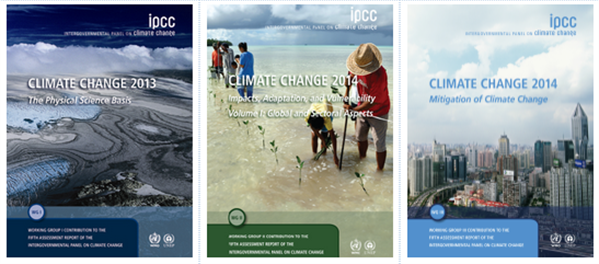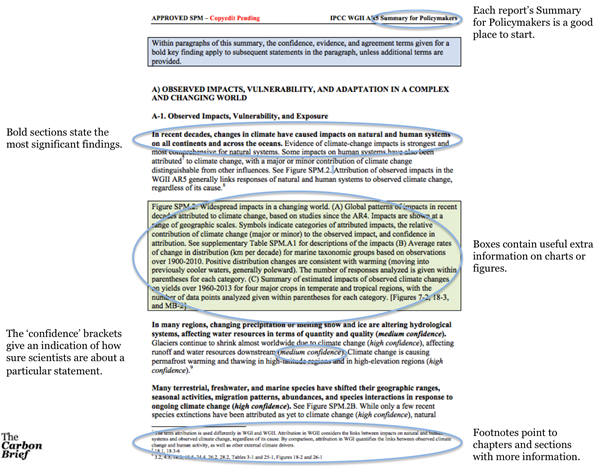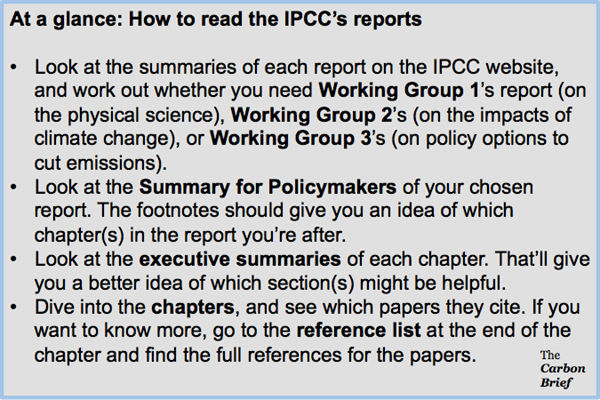Mat Hope
13.04.2014 | 10:02amThe UN’s three new climate reports are thousands of pages long and contain a huge amount of detail on topics as diverse as flood risk to bioenergy. So how do you stop them from becoming the world’s best-researched doorstop? Here’s our guide to navigating the reports.
Three reports
Three publications make up the Intergovernmental Panel on Climate Change’s (IPCC) comprehensive review of climate change research, known as the Fifth Assessment Report (or AR5). As they’re such big pieces of work, the IPCC only produces a new assessment report every five or six years.
So where do you start? First, make sure you’re reading the right document.
Responsibility for writing the reports is shared across three sets of scientists, known as Working Groups (sometimes referred to as WGs).
The WG1 report was released last September, WG2 came out yesterday, and WG3 is due in a week’s time.
The Working Group 1 report looks at the physical scientific aspects of the climate system and climate change. Working Group 2 is tasked with assessing the impacts of climate change, and options for adapting to it. Working Group 3 tries to work out how policymakers can reduce global greenhouse gas emissions, and curb climate change.
In addition to each of the working group’s reports is a synthesis report which brings together all of the IPCC’s research.
Structure
The IPCC’s reports are full of interesting stuff, but the sheer weight of information means the specifics can sometimes be hard to find. To help people out, it puts a few shortcuts in the reports to help people find what they’re looking for.
For starters, it produces a summary document for each – known as the Summary for Policymakers (SPM). If you’re looking for a specific topic or finding in any of the reports, the SPM is the best place to start.
The SPMs are generally under 50 pages, and are meant to give people a broad overview of what the report say, and where to find more information.
Once you’ve worked out which report and section you want (we show how below), it’s worth digging into each chapter’s executive summary. These are summaries of around three pages outlining what’s in each chapter, and where you can find it.
Once you’ve found the specific passage you’re after, dive in! If you want any more information, it’s worth checking out what research the report cites (given in brackets in the text). You’ll find the full references for the journal articles and books used in the reports at the end of each chapter.
Helpful lot that they are, the authors have also pre-empted their readers and included a handy list of Frequently Asked Questions at the end of each chapter.
Reading the report
The IPCC’s reports can be pretty intimidating at first glance. But once you know what’s what, they’re actually not that hard to get into.
Here’s an example of what a page from an IPCC report looks like:
The bold lines give the most significant findings. The sentences underneath add a bit more detail on that particular point.
The footnotes say which of the report’s chapters and sections the finding comes from. The first number refers to a specific point the text, the second number the chapter, and the third the section. So this footnote…

… refers to footnote 14, chapter three, section two (on observed hydrological changes due to climate change, since you asked).
The IPCC has also introduced confidence statements for AR5 to communicate how certain authors are about each finding. These appear in italics in brackets next to the text. They’re designed to be a quick way of seeing how much certainty there is about each finding.
The IPCC expresses its confidence about particular findings as “very low,” “low,” “medium,” “high,” or “very high” depending on how much evidence there is for each statement. It’s up to the authors of each section to agree on the confidence level.
So in this case (on page 8 of AR5’s WG2 SPM – if you can’t remember what that means, return to ‘go’)…
… the authors are highly confident the evidence suggesting climate hazards can affect people’s livelihoods.
Happy browsing
Reading the IPCC’s reports isn’t so hard once you know their quirks. Here’s an at-a-glance guide to help you on your way:
Now, enjoy.





